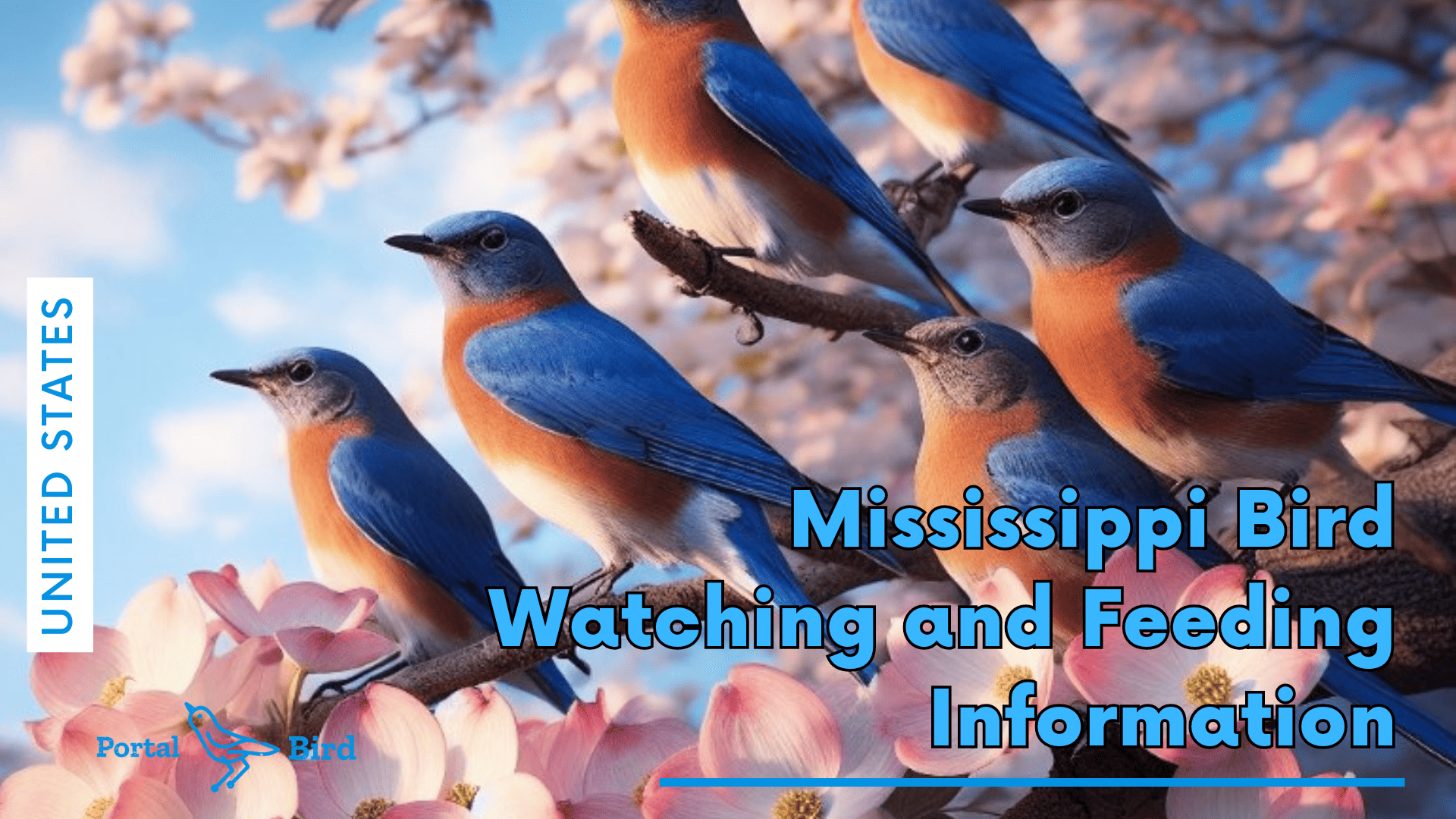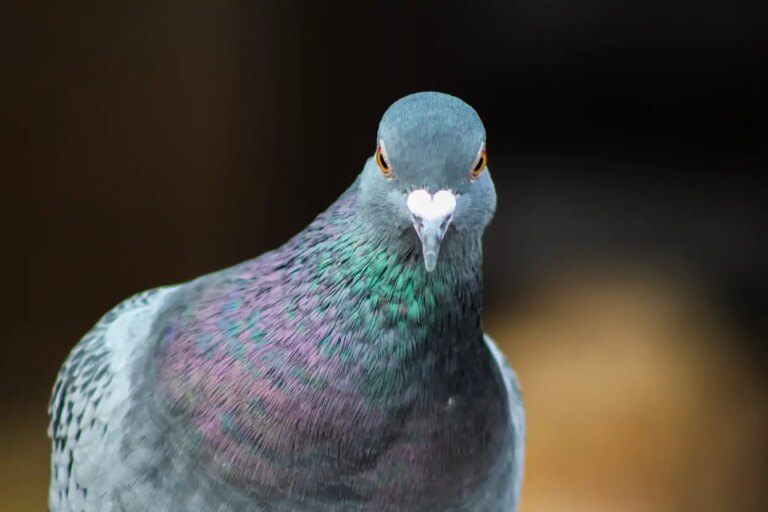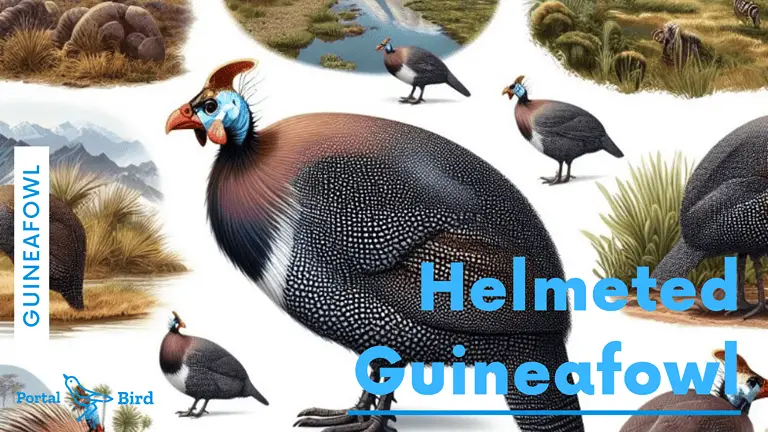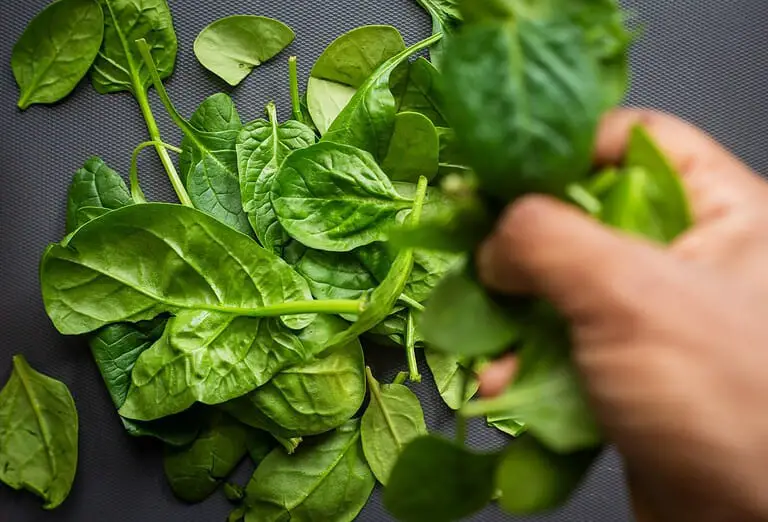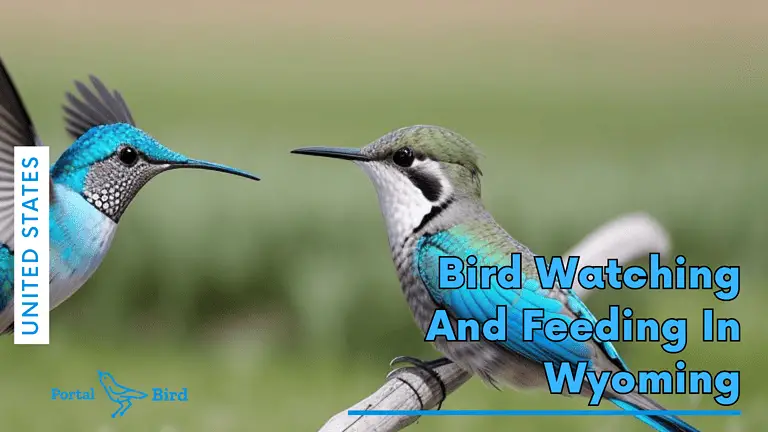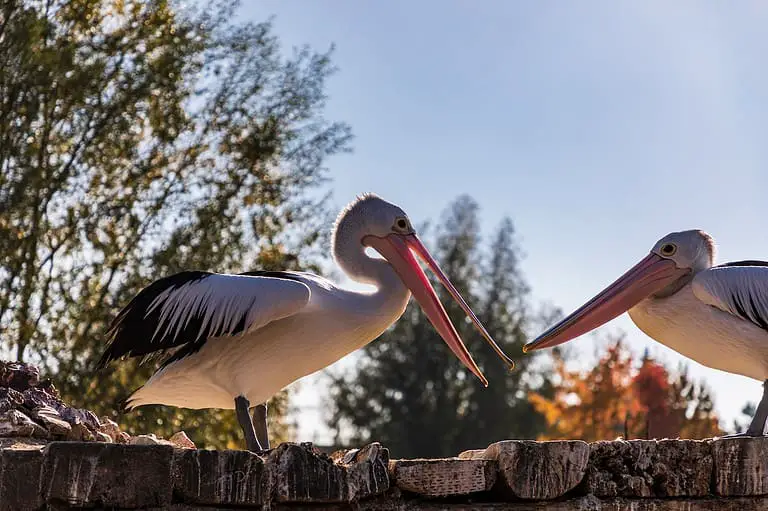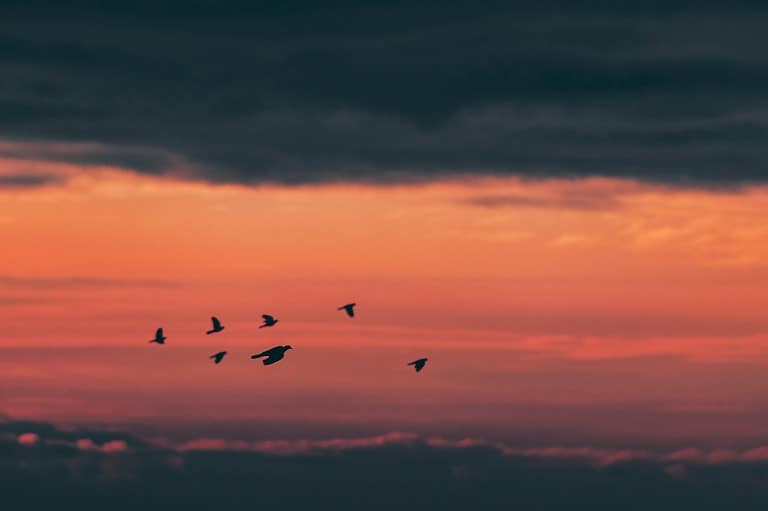Mississippi Bird Watching and Feeding Information
Mississippi Bird Watching and Feeding Information – Mississippi is a great place to watch and feed birds. Birdbaths, misters, and drippers are especially effective in attracting birds, including non-seed-eating species.
The Northern Mockingbird is the state bird of Mississippi. As you may know, mockingbirds are known for their melodic songs and ability to mimic other birds. They can often be seen perched prominently while singing.
These gray birds with black-and-white wings are residents throughout Mississippi year-round. Providing water features, cover, and food sources in your yard helps support mockingbird populations and other bird species native to the area.
Common Birds to Attract to Feeders
Species that might be expected at feeders include: American Goldfinch, Carolina Chickadee, Blue Jay, Downy Woodpecker, Northern Cardinal and Mourning Dove.
Each of these species is shown in the Nifty Fifty mini-guide. Providing a variety of foods, including seeds, nuts, fruits, suet, and nectar, will attract different species to your backyard. Here are some details about these common birds:
| Bird | Description | Food Preferences |
|---|---|---|
| American Goldfinch | Small bright yellow bird with black wings | Nyjer seed, hulled sunflower seeds |
| Carolina Chickadee | Gray bird with black cap and bib | Sunflower seeds, peanut bits, mealworms |
| Blue Jay | Large crested gray and blue bird | Peanuts, acorns, corn, suet |
| Downy Woodpecker | Smallest of the woodpeckers with black and white barring | Suet, nuts such as peanuts |
| Northern Cardinal | Briliant red bird with crest | Sunflower seeds, millet, cracked corn |
| Mourning Dove | Gray bird with black spots and tip on wings | Millet, cracked corn, berries |
The Nifty Fifty Birds of Mississippi
The Nifty Fifty is a mini-guide to the birds of Mississippi. It includes descriptions, images, video and songs of 50 of the most often observed birds of Mississippi.
This is a useful resource for birdwatchers of all experience levels to learn more about the diversity of avian species found within the state.
Whether beginning your birding exploration or adding new observations to your lifetime list, the Nifty Fifty guide provides valuable information and identification points to aid you.
Developing Bird-Friendly Habitat
Providing an abundant, diverse food source is important to attract birds year-round. Developing bird-friendly habitat in your yard is the best way to support local and migrating species naturally.
Native plants are especially beneficial because they provide food and cover well-adapted to the local climate and conditions.
Native species are also typically more resistant to disease and pests than non-native plants, reducing maintenance needs. Some key native plants to consider including in your landscape are:
- Oak trees – Acorns are an essential mast crop for many birds and other wildlife in fall and winter
- Dogwood – Produces berries eaten by over 15 species including songbirds, cardinals and mockingbirds
- American beautyberry – Showy purple berries remain on bushes into winter, providing food for birds like eastern bluebirds and eastern towhees
- Blackberry/raspberry – Produces fruit eating birds love from summer into fall
- Sunflowers – Seeds are devoured by finches, sparrows and other seed-eating birds
- Partridge pea – Seed pods provide nutrition for quail, doves and songbirds
- Goldenrod – Provides seed heads grazed on by sparrows and finches in fall
Having a diversity of native plant species that provide food during different seasons ensures birds have continual sustenance available naturally within the habitat you create.
Refer to the recommended native plant lists from local Audubon societies or agricultural extension services for species well-adapted to your area.
Bluebirds in Mississippi
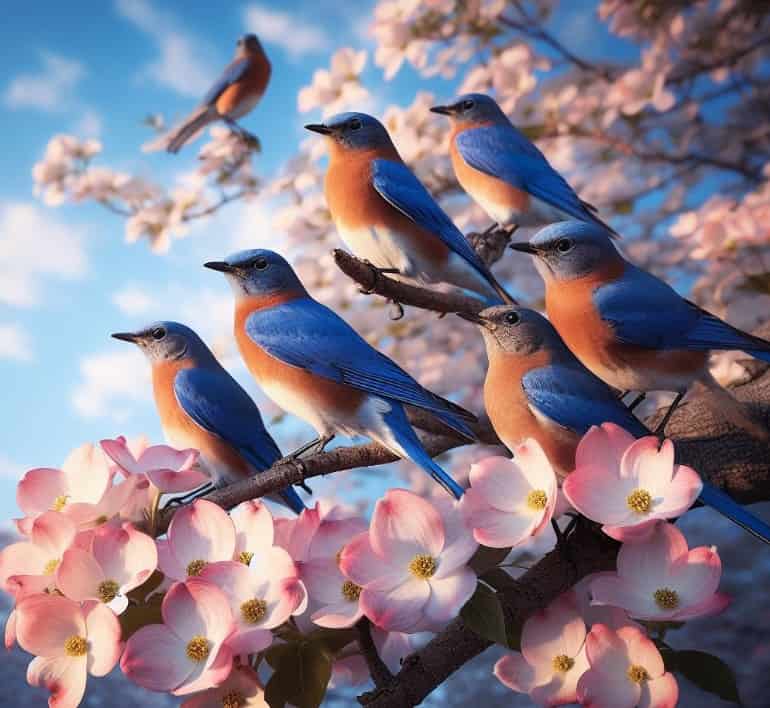
The eastern bluebird is a permanent resident in Mississippi. Populations increase during the winter months as more northern populations move south for the winter. With their handsome shade of azure and tendency to nest in orchards, pastures and yards, eastern bluebirds always delight when spotted. Their melodic songs spread a cheerful air in springtime.
Providing nest boxes specifically made for eastern bluebirds can encourage them to nest successfully on your property. Place boxes away from trees and facing east or north for protection from hot afternoon sun. Drill 1-inch entrance holes to prevent larger birds like House Sparrows from competing with bluebirds.
Monitor boxes weekly to remove abandoned nests between broods. Supplemental feeding of mealworms, suet or fruit in winter provides extra calories to help bluebirds survive cold spells. Refer to the bluebird section of this guide for full nest box specifications and placement guidelines.
Characteristics and Behavior of Eastern Bluebirds
- Males have a brilliant blue upperpart and rusty brown breast, females are lighter in color
- Average size is about 8 inches long with a Wingspan of 11-12 inches
- Has a pleasant, musical song and similar easy-to-identify flight call
- Most often found in open woodlands, parks, fields, along golf courses and cemeteries
- Can be found in suburban areas with adequate open space for foraging and nesting
- Insectivorous diet includes beetles, spiders, caterpillars and grasshoppers
- Aggressively defend territories and nest sites from other species like House Sparrows
- Typical clutch size is 4-5 sky blue eggs laid daily between late March through July
Observing these songbirds go about their daily activities of foraging, singing to establish territories, and feeding fledglings provides an uplifting experience. Their cavity-nesting lifestyle makes them well-suited for yards with nest boxes. With a little help, eastern bluebirds will surely add their beauty and songs to brighten your springtime garden.
Hummingbirds in Mississippi
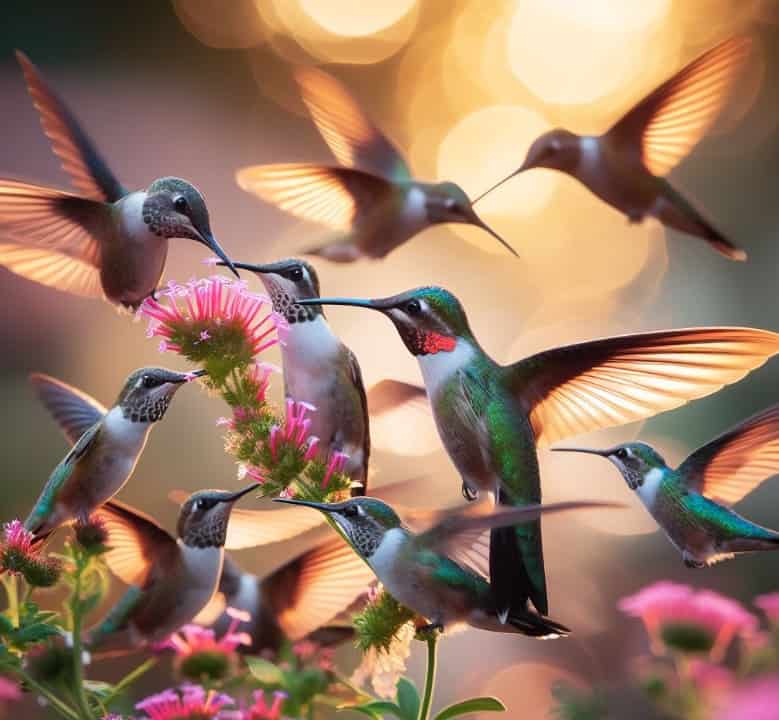
The Ruby-throated Hummingbird is the only species that regularly visits Mississippi. It nests in the state each year, before migrating south again for the winter. While most humans would not want to fly across the expanse of the Gulf of Mexico twice a year, these tiny hummingbirds can feather that accomplishment.
Male Ruby-throated Hummingbirds are identifiable by their iridescent ruby throats that appear black at some angles. During their southern migration from late August into September, you may spot a hummingbird with gray flanks indicating it is female or immature.
Providing nectar feeders year-round with a 4-parts-water to 1-part-sugar solution refreshed every 2-3 days can make your property an oasis for hummers on their biannual journeys. Be on the lookout from April into September for the opportunity to observe these aerial miracles up close.
Tips for Attracting Hummingbirds
- Place multiple feeders around landscape for best coverage
- Locate near flower or tree canopy for natural perches near food
- Use red-colored feeders as hummingbirds are strongly attracted to red
- Ensure feeders are easy to access by removing leaf litter or other obstacles
- Clean feeders weekly with a diluted bleach solution to prevent mold growth
- Be patient as it can take hummingbirds time to discover new food sources
- Enjoy viewing the hyped up aerial antics and acrobatics of territorial males
- Look for diminutive nests of plant down and spider silk, often on tree limbs
Offering safe habitat, food and shelter benefits these tiny long-distance travelers. Increase your chances of witnessing hummingbird behaviors up close by implementing several of these attraction recommendations.
Purple Martins in Mississippi
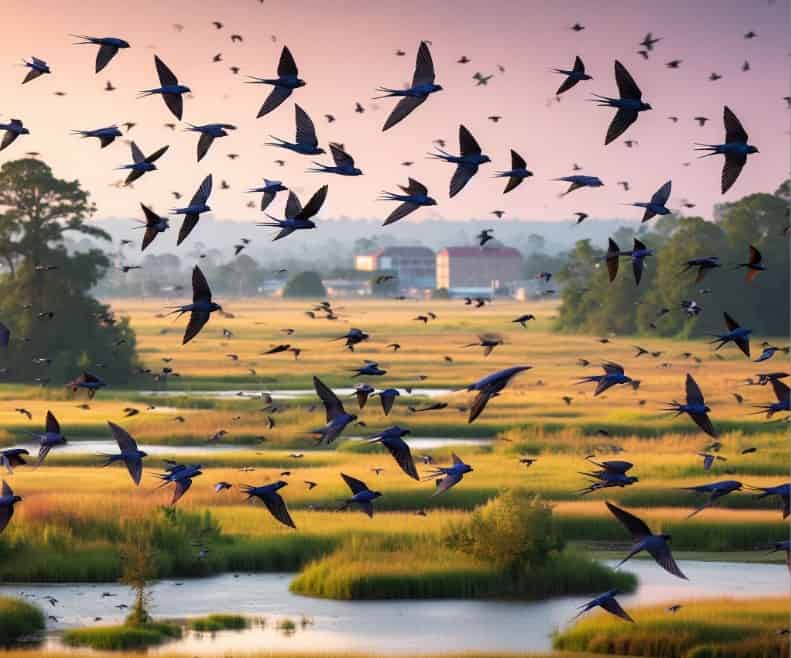
Purple Martins arrive in Mississippi in mid to late February, returning from their wintering grounds in South America. They are a welcome sight for many backyard birders and help control insect populations around homes. However, their cavity-nesting lifestyle means natural nest sites can be limited. Providing martin houses is one of the most impactful actions to actively support these aerial insectivores.
Setting up housing and ensuring it is predator-proof and ready for tenants by February will signal to scouts it is a good location to raise young. Monitor houses daily to quickly remove sparrow or starling nests that can prevent martins from utilizing boxes.
Clean out old nests between broods too. With a little maintenance, your property could be transformed into a thriving martin colony that returns annually. Check the Purple Martin section for full housing specifications and landlord responsibilities.
Characteristics of Purple Martins
- Largest North American swallow at 6-7 inches long
- Glossy steel blue upperparts and pale gray or white underparts
- White rump patch visible in flight
- Graceful and acrobatic flyers that feed solely on airborne insects
- Colonial cavity nesters that benefit from human-provided housing
- Loud squeaky chip calls and gurgling song are easily recognizable
Purple Martin Scouts
As mentioned previously, the first martins to arrive each spring are called scouts. These dedicated birds work to claim the best nesting territories in order to attract mates and build nests. When scouts appear in mid-February in Mississippi, it signals spring is on its way.
Scouts can often be seen flying aerial assessments of vacant houses, perched prominently calling advertisements of vacancy. They may even begin collecting nest material during inspections.
Landlords can attract these early arrivals by cleaning old nests out of housing now before the main colonies arrive in March. Be diligent about ongoing checks and removal of exotic nests such as those of House Sparrows which threaten martin residency.
With a little preparation and care, scouts will choose your houses and begin the cycle anew of another successful hatching season. Their timely arrival heralds the return of these aerial acrobats that help control mosquitoes and other nuisance insects through summer months.
Migration of Purple Martins
The marathon journeys Purple Martins undertake each year between their temperate North American breeding grounds and South American wintering locales are truly remarkable. From Mississippi, flocks head south beginning in July to reach destinations thousands of miles away by September.
Their fall migration path takes three main routes – down the Mexican coastline, across the Gulf of Mexico, or island hopping through the Caribbean. These various flyways ensure safety in numbers and optimize resources for the long flight. Once in South America, martins congregate in massive roosts of hundreds of thousands until it’s time to return north the following February or March.
By undertaking bi-annual migrations of up to 5000 miles round trip, Purple Martins demonstrate exceptional navigational abilities and endurance. Their loyalty to traditional nesting and wintering sites spanning generations is also impressive. As climate change impacts patterns, they will need our help providing more nesting houses to accommodate fluctuating populations. Observant birders may spot migrating flocks moving through their localities come late summer.
Birding in Mississippi
Mississippi’s diverse habitats ranging from coastline to forests and wetlands support a variety of bird species year-round. Some prime birding locations in the state include:
- Grand Bay National Wildlife Refuge – Over 260 species reported, including migrating shorebirds and waterfowl.
- Tibbee Creek-Puskus Lake Natural Area – Mixed pine and hardwood forest ideal for woodpeckers, warblers and more.
- Roosevelt State Park – Pine savannah and oak-hickory forest attract eastern bluebirds, red-headed woodpeckers and Bachman’s sparrows.
- Ross Barnett Reservoir – Popular for waterbirds, raptors and herons along its shores. Kayaking allows access to remote islands.
- buoy 10 Birding Trail – 8 miles of trails and boardwalks through coastal marsh great for seaside specialties like black skimmers andwood storks.
Professional and amateur birders frequently lead guided trips to areas like these to help visitors of all skill levels spot birds and learn identification techniques. Learning calls and having binoculars readily accessible improves wildlife viewing experiences. For those new to the pastime, birding festivals provide mentored introductions.
Purple Martin Nesting and Parenting
After choosing houses and courting mates, martins get busy with nest-building by mid-March. Pairs work cooperatively to assemble bulky nests of grass, twigs and feathers that will cradle their eggs. One per day is laid until the completion of most clutches around five or six.
Incubation duties are shared for 15 days until tiny altricial chicks hatch. Both parents diligently feed the ravenous young by catching insects on the wing and depositing them into open beaks. Chicks grow quickly and fledge, leaving the nest for short flights, after 20-25 days.
Colonial living provides safety in numbers from predators. Adults may even abandon a whole house if disturbances occur too close to occupied nests. By late summer, chicks from first broods have matured enough to begin their long flight south as the season ends.

